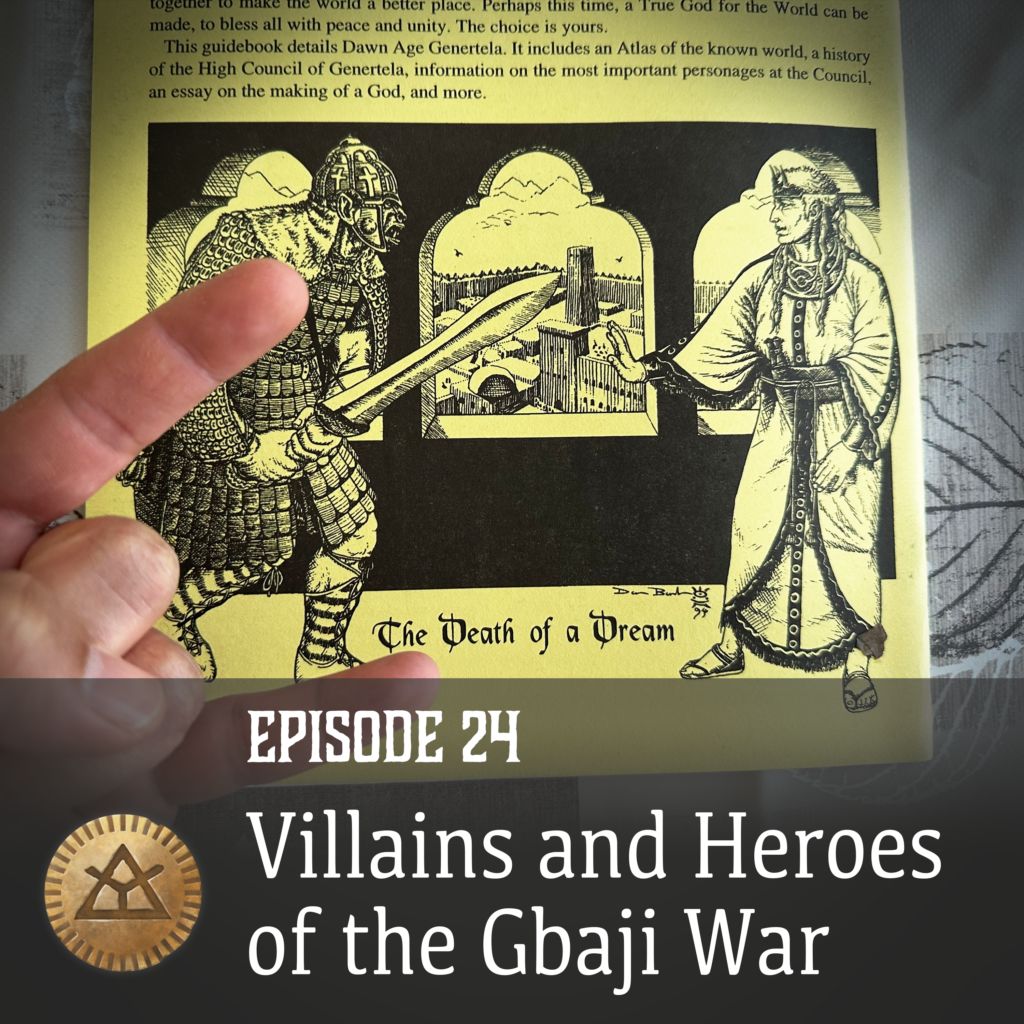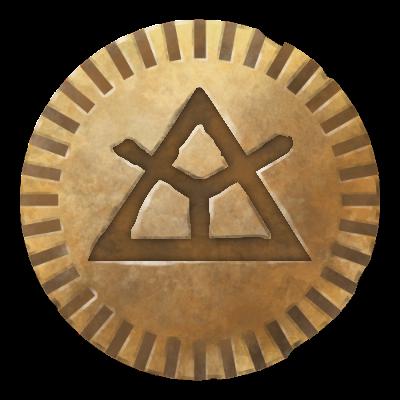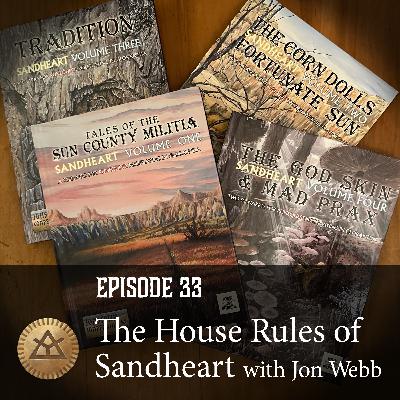Episode 24: Villains and Heroes of the Gbaji War
Description
 <figcaption class="wp-element-caption">Art by Dan Barker, from the Broken Council Guidebook</figcaption></figure>
<figcaption class="wp-element-caption">Art by Dan Barker, from the Broken Council Guidebook</figcaption></figure>We start this episode with a minor existential crisis on Ludo’s identity, followed by Ludo being protective of our usual guests by volunteering to take the brunt of Jörg’s incoming obscurantism and pedantry. Ludo accuses rather than praises Jörg of being a bright guy…
Main Topic
The Second Council and its God Project
Jörg wants to go to the beginning of that God Project, which was in his opinion the discovery of the Pseudocosmic Egg in the ruins of Dorastor. He mentions the Dawn Age appendix in the Guide, p.712 if you want to take a deeper read into this. (If you own the old RQ3 Dorastor Book, it has this text, too.)
Ludo asks whether the Pseudocosmic egg, that rare artifact which was instrumental in creating the perfect god, was just lying around in those ruins, and Jörg name-drops the Feldichi builders of those ruins, suggesting that the artifact would have been sitting in a Feldichi laboratory.
The ruins were first discovered by the early settlers, in the 120ies. Ludo paints this time (prior to hostile contact with the Horse Warlords in Dara Happa) as a time of peace and plenty.
We talk about the nature of the Pseudocosmic Egg, an artifact which Jörg describes as something that spoke to its investigators, awakening creative urges that ultimately led to the decision to breed a perfect deity.
Its origin isn’t clear, although Jörg wouldn’t be Jörg if he did not have a theory about that.
A rather weird theory, describing the Egg as an unborn child of Mostal, the World Machine, which would be a von Neumann probe in this theory – a self-replicating mechanism establishing a universe and then spawning daughter universes, more places like Glorantha. Only Mostal was damaged by the birth of Umath, and the hatching of the egg (in Jörg’s theory one of eight) was interrupted.
This gives the entire Dorastor civilization (both the Feldichi and the Second Council) a certain science-fantasy vibe, which is fine with Jörg.
Anyway, the people investigating the egg start the God Project.
Ludo expounds on their possible motivations: having the gods around again. (An effect which is called “Proximate Holy Realm” by Jeff Richard, describing the vicinity of deities in Belintar’s City of Wonders, but which also seems to have been the goal of the EWF Third Council.)
People of the God Project
Jörg briefly introduces Lokamayadon as the new Orlanthi member of the Second Council, a Pelorian, non-Heortling Orlanthi, and his personal feud against the family of the Vanak Spear heroes in the Berennethtelli tribe (who were Heortlings), foreshadowing Harmast Barefoot who was one of their descendants.
Being forced back onto the God Project, Jörg drops another name of the participants, Holy Estorex, a Dara Happan mystic who becomes one of the chief contributors to the new deity.
Ludo mishears the name as Asterix, the cartoon hero by Goscinni and Uderzo whose adventures in and from Roman occupied Gaul are a great inspiration for the Sartarites despite being very non-Sartarite.
Leaving that aside, we talk about what the Dara Happans want from this.
For context: up to 221, since before the Dawn, the Dara Happans and other Pelorian lowlanders were ruled by horse warlords who immigrated from the Arcos Valley and established a semblance of order in the Gray Age while remaining quite barbaric themselves. These horse-warlords slaughtered any Lightbringer Missionaries entering their territory, which earned them the enmity of the Council in Dorastor, and led to its first war, culminating in the Battle of Argentium Thri’ile in 221 (a name wisely – or cowardly – not pronounced by Jörg).
Jörg talks about the effect of having Holy Estorex on the God Project, which led to new advances, and a grwoing unease of the trolls, the Heortlings and the Dragonewts, all of whom ultimately break off from the project and their participation in the Second Council, which is called the Broken Council afterwards.
Ludo describes the Dara Happan representative as the Yoko Ono of the Second Council.
(A pop culture reference as old as the older part of our audience: this is about the break-up of the Beatles, one of the most infliential bands of the late sixties and early seventies of the last century. As if “pop” in pop culture stands for “dad” or “granddad”…)
We talk about how this representation of all elements is an ongoing theme, like with Belintar’s Holy Country, and a reflection of the universe. Which gets Jörg to drop in the Young Elementals, source of the non-moon elemental magic of the Seven Mothers Cult, who were the spawn of the Pseudocosmic Egg alongside Osentalka.
Enter the Antagonists Nysalor and Arkat
Fast-forward to the Sunstop, with Jörg listing other culprits like the Kralori emperor meditating, Western wizards fighting shamans in Fronela, a new bloom in the Yellow Elf forests in Pamaltela.
Ludo observes that these pivotal moments in Gloranthan myth or history always have multiple causes and participants.
Jörg adds that he is pretty sure Zzabur had something to do with the cause of the Sunstop, too.
Ludo asks whether the Sunstop was a bad thing, and Jörg forwards the Dara Happan notion that this would be the ideal state of the world, re-creating the ideal of Godtime. The trolls on the other hand might think this is the worst idea possible – at least those who were condemned to a life on the Surface World.
Jörg tries to convey that while (normal) Time stopped, lives went on. Hence “the Sunstop lasted for an unknowable amount of time” doesn’t mean that everybody was frozen in their movements (as that would mean they wouldn’t even notice the Sunstop).
Necessarily, Jörg mentions the birth of Arkat in the distant forests of Brithos, probably as the result of a tryst with a deity (these things happen in the Malkioni west all the time in that age), a deity who leaves his mortal offspring the Unbreakable Sword.
Looking back at Dorastor, Ludo asks whether Nysalor was born with a cool magical item like his counterpart, or whether Arkat gets preferential treatment by the GM. Jörg points out that Nysalor is born with a partially restored magical city to his name, while Arkat starts out in the wilderness.
Jörg clarifies that he meant the magical buildings left behind by the Feldichi and brought into a semblance of function by the Second Council. With the possibility that Osentalka’s birth awakens the ruins more than before.
Ludo asks whether the two antagonists were born as infants. Jörg opines that Arkat was indeed born the biological way as a baby, whereas Nysalor probably came into the world as a fully grown adolescent, a shape he retained trhoughout the rest of his life.
Coming to the end of the Sunstop, Ludo asks how this ended. Jörg first gives the observations that were passed on through the generations: dark strands forming around the sun, dragging it back onto its Sunpath procession. Some people call that the Web of Arachne Solara, and Ludo imagines a “pissed-off” Arachne Solara. Jörg suggests that the Sun Spider (Arachne Solara) and her son Time pull the sun back onto its cycle,
The perfect god Osentalka (who could only exist under the perfect conditions of the Sunstop) becomes revered as Nysalor, the Bright Lord.
Ludo asks whether this demand for perfection is part of an in-world sage’s agenda, or whether this is an objective observation. Jörg evades the question, re-stating that there was Osentalka who was perfect while Time had stopped, but when it re-started again, the deity now named Nysalor had imperfections.
Ludo tries to play that down as excuses. Jörg argues that Nysalor doesn’t do or need excuses, since he is illuminated. We discuss who might have apologized, but other than some humans on the council (illuminated by the time they could be interviewed) we don’t find who might have apologized. Certainly not the Mostali who were involved.
Ludo summarizes what we said about the Bright Empire in our last episode – a Solar-themed empire that took over vast chunks of Central and even Western Genertela.
Heroes of the Bright Empire
Jörg brings up the Battle of Night and Day, where the friends and foes of Nysalor met three years after the Sunstop. While the battle is described in quite a lot of detail in the Stafford Library offering History of the Heortling People (from the perspective of Lokamayadon), Jörg attempts to give an elevator pitch of those details.
Ludo asks how the battle went. It started with conventional warfare (other than Lokamayadon riding his flying ram while the King of the Heortlings is riding a cloud, which Ludo agrees is fairly conventional for Gloranthan warfare).
The Dara Happan forces facing the trolls are faring badly, and the Dara Happan general asks his Vanchite (hill barbarian aka Orlanthi) charioteer whether he had any hidden trump card. The charioteer replies, “Try my god, Daysenerus, the planet Lightfore.”
Ludo asks whether we are talking about Yelmalio, which is of course another name for this sort of divine presence.
Ludo also wonders whether the charioteer






